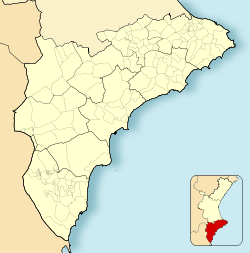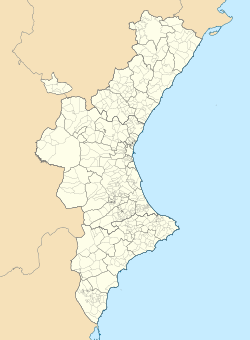Dénia
Denia
| |
|---|---|
 View of Dénia from the Montgó out to sea | |
 Flag  Coat of arms | |
 Denia Location in Spain | |
| Coordinates: 38°50′40″N 0°6′40″E / 38.84444°N 0.11111°E | |
| Country | |
| Autonomous community | |
| Province | Alicante |
| Comarca | Marina Alta |
| Judicial district | Dénia |
| Government | |
| • Mayor | Vicent Grimalt (PSOE) |
| Area | |
| • Total | 66.2 km2 (25.6 sq mi) |
| Elevation | 22 m (72 ft) |
| Population (2018)[1] | |
| • Total | 41,733 |
| • Density | 630/km2 (1,600/sq mi) |
| Demonym(s) | denier(a) (va) dianense (es) |
| Time zone | UTC+1 (CET) |
| • Summer (DST) | UTC+2 (CEST) |
| Postal code | 03700 |
| Website | Official website |
Dénia (Valencian: ˈdenia; Spanish: Denia [ˈdenja]), is a historical coastal city in the province of Alicante, Spain, on the Costa Blanca halfway between Alicante and Valencia, and the capital and judicial seat of the comarca of Marina Alta. Denia's historical heritage has been influenced by Iberian, Greek, Roman, Islamic, Napoleonic and Christian civilizations. As of 2014, it had a population of 41,672,[2] although this is more than doubled by tourism during the summer months.
History[]
There is evidence of human habitation in the area since prehistoric times and there are significant Iberian ruins on the hillsides nearby. In the 4th century BC it was a Greek colony of Marseille or Empúries,[citation needed] perhaps the one mentioned by Strabo[3][4] as Hēmeroskopeion (Greek: Ημεροσκοπείον) (meaning "watchtower"). It was an ally of Rome during the Punic Wars, and later was absorbed into the Roman Empire under the name of Dianium (after their goddess Diana). In the 1st century BC Quintus Sertorius established a Roman naval base here.[5]
In 636-696 AD, during the Visigothic Kingdom of Iberia, it was the seat of a bishop from Toledo. After the Muslim conquest of Iberia and the dissolution of the Caliphate of Córdoba, Dénia (known as Dāniyah or دانية in Arabic which means lowland) became the capital of a taifa kingdom that reigned over part of the Valencian coast and Ibiza. The Slavic Muslim slaves, saqālibah, led by their leader, who could take profit from the progressive crumbling of the Caliphate's superstructure to gain control over the province of Dénia. The Saqaliba managed to free themselves and run the Taifa of Dénia which extended its reach as far as the islands of Majorca and its capital . The Saqaliba Taifa lost its independence in 1076, when it was captured by Ahmad al-Muqtadir, lord of Zaragoza, under which it remained until the Almoravid invasion in 1091. The Muslim Arabs originally built the castle fortress, and the French, who occupied the city for four years during the Peninsular War, re-built it in the early 19th century.

The town was reconquered by the Christians in 1244. This caused a decline for the city, which remained nearly uninhabited after the exile of most of the Muslim population. It was later repopulated by the Valencian government. Created a fief in 1298, it was held by the de Sandoval family from 1431, although the city itself was returned to Aragonese crown in 1455. A marquisate from 1487, Dénia gained many privileges thanks to Francisco Gómez de Sandoval y Rojas, Duke of Lerma, a favourite of Philip III of Spain. It suffered a further period of decay after the decree of Expulsion of the Moriscos (1609), by which 25,000 people left the marquisate, leaving the local economy in a dismal state.
During the War of the Spanish Succession Dénia was besieged by 9,000 French troops in June 1707, who broke down several sections of the town walls using cannon, but their attacks in July were repulsed by the small garrison with great loss of life to the attackers resulting in the siege being raised after 27 days. Dénia, however, fell to the French forces that November. In 1713 the Treaty of Utrecht recognised Louis XIV's grandson Philip, Duke of Anjou, as King of Spain (as Philip V), so returning Dénia to Spanish rule.
It was reacquired by the Spanish crown in 1803, after which Denia gained an increasingly important role as a trading port. A community of English raisin traders lived in Denia from 1800 until the time of the Spanish Civil War in the late 1930s.
Main sights[]
Dénia is home to a large Moorish castle named on a rocky crag overlooking the city. It was built in the 11th and 12th century and offers views around the sea, the city and the surrounding area. Located in the castle is the and its corresponding museum.
Dénia also has the Museu Etnològic with further details on the history and culture of the city.
Climate[]
Dénia has a Mediterranean climate (Köppen Csa), with mild winters and hot summers. The mean temperature of the coldest month (January) is 12.3 °C (54.1 °F), while the mean of the hottest month (August) is 26.8 °C (80.2 °F).[6] The city enjoys over 2800 sunshine hours per year.[7]
| hideClimate data for Dénia, Spain | |||||||||||||
|---|---|---|---|---|---|---|---|---|---|---|---|---|---|
| Month | Jan | Feb | Mar | Apr | May | Jun | Jul | Aug | Sep | Oct | Nov | Dec | Year |
| Average high °C (°F) | 17.2 (63.0) |
18.1 (64.6) |
19.7 (67.5) |
21.6 (70.9) |
24.6 (76.3) |
27.9 (82.2) |
30.9 (87.6) |
31.6 (88.9) |
28.9 (84.0) |
25.0 (77.0) |
20.7 (69.3) |
17.8 (64.0) |
23.7 (74.6) |
| Daily mean °C (°F) | 12.3 (54.1) |
12.8 (55.0) |
14.7 (58.5) |
16.3 (61.3) |
19.2 (66.6) |
22.7 (72.9) |
25.4 (77.7) |
26.8 (80.2) |
23.6 (74.5) |
20.0 (68.0) |
15.9 (60.6) |
13.2 (55.8) |
18.6 (65.4) |
| Average low °C (°F) | 7.4 (45.3) |
7.6 (45.7) |
9.7 (49.5) |
11.0 (51.8) |
13.8 (56.8) |
17.5 (63.5) |
20.0 (68.0) |
22.1 (71.8) |
18.3 (64.9) |
15.1 (59.2) |
11.1 (52.0) |
8.5 (47.3) |
13.5 (56.3) |
| Average precipitation mm (inches) | 37 (1.5) |
56 (2.2) |
48 (1.9) |
31 (1.2) |
35 (1.4) |
24 (0.9) |
7 (0.3) |
18 (0.7) |
66 (2.6) |
87 (3.4) |
84 (3.3) |
98 (3.9) |
591 (23.3) |
| Source: climate-data.org[6] | |||||||||||||
Transportation[]
The ferry to Ibiza and the other Balearic Islands departs daily. Until 2005, the city also served as the northern terminus for a 1,000 mm (3 ft 3+3⁄8 in) metre gauge railway line through the mountains from Alicante (popularly known as the Limón Express), run by FGV. This was not a specific tourist railway; it provided transport throughout the year and was geared to commuter use. Efforts have been made to re-open the line, so far without success.[citation needed]
Culture[]

The bonfire festival is celebrated each March. Huge papier-mâché statues called fallas are set up throughout the town, and then set ablaze.
The Bous a la Mar (meaning "Bulls at the Sea") is held in July. The highlight of this week-long festival is watching bulls run down the main street Marqués de Campo, only to be chased into the Mediterranean sea by those daring enough to enter a makeshift bull ring with them.
Since 1974 it has been home to painter and sculptor Joan Castejón. The town honored him as an Adoptive Son of Dénia in 1999.
Notable people[]
- Abu al-Salt, Andalusian polymath
- Joan Castejón, sculptor
Sports[]
Dénia's local football team is called Club Deportivo Dénia, and plays in Spain's Third Division.
Twin towns[]
 Cholet, France
Cholet, France
See also[]
References[]
- ^ Municipal Register of Spain 2018. National Statistics Institute.
- ^ "Instituto Nacional de Estadística. (Spanish Statistical Institute)". Ine.es. Retrieved 4 November 2016.
- ^ Strabo (1903). "4". In Falconer, M.A. (ed.). The Geography of Strabo. Literally translated, with notes, in three volumes. 3. Translated by Hamilton, Esq., H.C. London: George Bell & Sons. Retrieved 10 July 2020.
Of these the best known is Hemeroscopium. On the promontory there is a temple to Diana of Ephesus, held in great veneration. Sertorius used it as an arsenal, convenient to the sea, both on account of its being fortified and fitted for piratical uses, and because it is visible from a great distance to vessels approaching. It is called Dianium, from Diana.
- ^ Strabo (1877). "4". In Meineke, A. (ed.). Geographica (in Ancient Greek). 3. Leipzig: Teubner. Retrieved 10 July 2020.
- ^ Parque Natural del Montgó - Estudio Multidisciplinar (in Spanish). Valencia: Conselleria d'Administració Pública, Agencia del Mediambient. 1990. p. 60.
- ^ Jump up to: a b "Dénia Climate". climate-data.org. Retrieved 30 October 2020.
- ^ "Valores climatológicos normales". AEMET. Retrieved 30 October 2020.
External links[]
 Media related to Denia - Dénia at Wikimedia Commons
Media related to Denia - Dénia at Wikimedia Commons Dénia travel guide from Wikivoyage
Dénia travel guide from Wikivoyage
- Municipalities in the Province of Alicante
- Tourism in Spain
- Mediterranean port cities and towns in Spain
- Greek colonies in Iberia
- Ancient Greek archaeological sites in Spain



